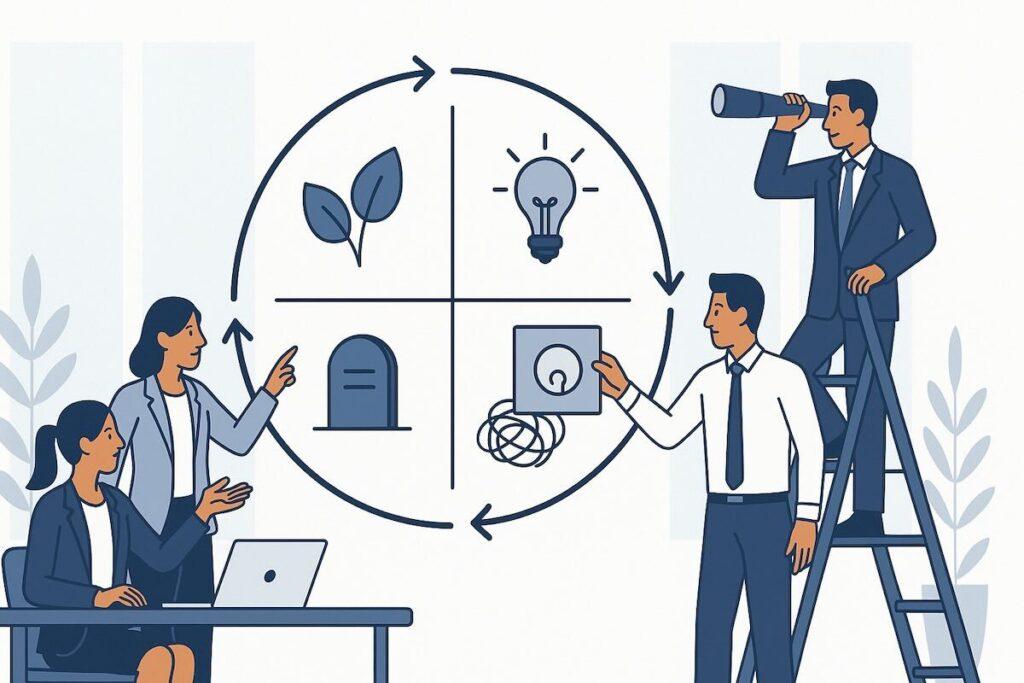The ecocycle mental model is a way to think about systems, inspired by nature. It helps leaders and teams understand how things grow and change. It’s based on C.S. Holling’s Adaptive Cycle Theory.
This model has four stages: birth, growth, maturity, and then a time for change and renewal. It’s used in many areas like organizational strategy and agile management. It also helps in leadership development and facilitating liberating structures.
The ecocycle model shows what’s working well, what’s not moving, and what needs to end. It’s a powerful tool for making better decisions and working together as a team. It’s great for handling changes in a fast-paced world.
Why the Ecocycle Mental Model Matters for Modern Organizations
In fast-changing environments, linear thinking often fails to capture the complexity of how systems grow, decline, and adapt. The ecocycle mental model offers a more realistic, cyclic view of how organizational elements evolve over time. Unlike traditional management tools that favor stability, the ecocycle sees destruction and renewal as essential phases—not failures.
This model is very useful for business leaders, change agents, and project managers who aim to build resilient systems. It encourages adaptive thinking, helping organizations avoid stagnation and spot innovation bottlenecks. As systems thinker David Hurst says, the ecocycle is “a tool for identifying where change is needed and where it’s already emerging.”
Understanding the Core Concept of the Ecocycle Mental Model
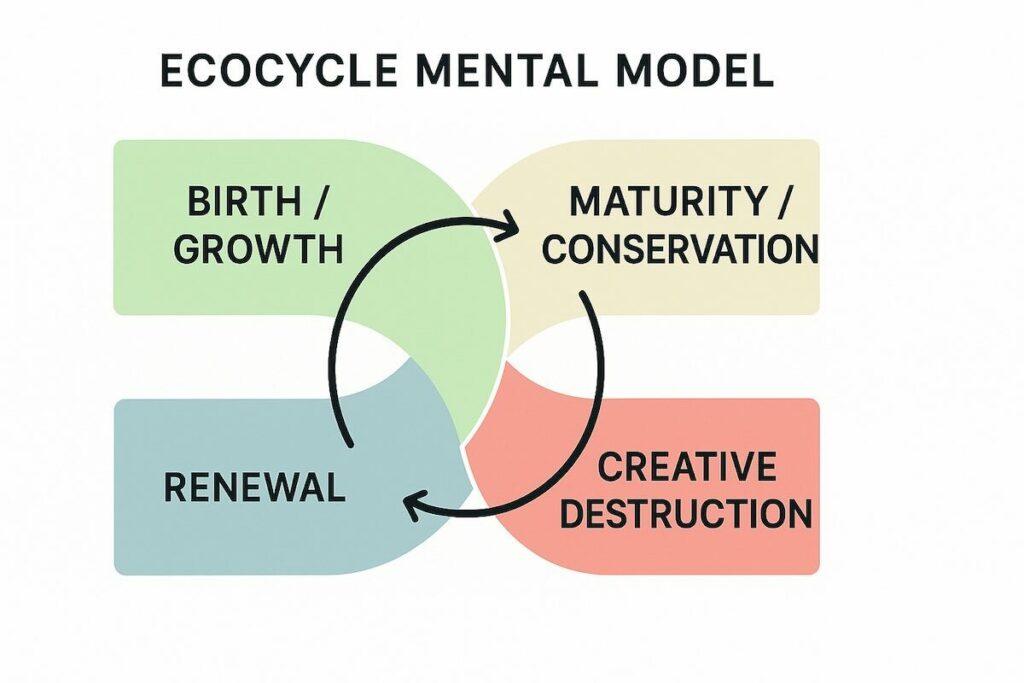
The Ecocycle Mental Model: Four Phases in a Continuous Cycle
The ecocycle mental model borrows from ecological systems, illustrating how all complex systems follow a natural progression through four distinct phases.
This mental model was originally developed by ecologist C.S. “Buzz” Holling as the “adaptive cycle” to understand forest and estuary dynamics. It has since been adapted for organizational and personal contexts, including the use of liberating structures to overcome activities rigidity trap, as emphasized by Keith McCandless and Henri Lipmanowicz in small groups.
Origins: From Ecology to Strategy
The ecocycle started as the adaptive cycle, a concept by ecologist Buzz Holling. It explained the life cycle of natural ecosystems, like forests and wetlands. It showed how these ecosystems grow, conserve, break down, and reorganize.
Later, this idea was used for organizational behavior, leadership development, and complex systems planning. It helped understand how to manage and grow in different areas.
People like Keith McCandless and Henri Lipmanowicz turned the ecocycle into a tool for planning. They created Liberating Structures. Now, it’s used worldwide in many fields.
It’s used in corporate retreats, agile coaching, nonprofit strategy, and education. It helps see where to focus next with energy, attention, and resources.
Visualizing the Ecocycle: A Nonlinear Journey
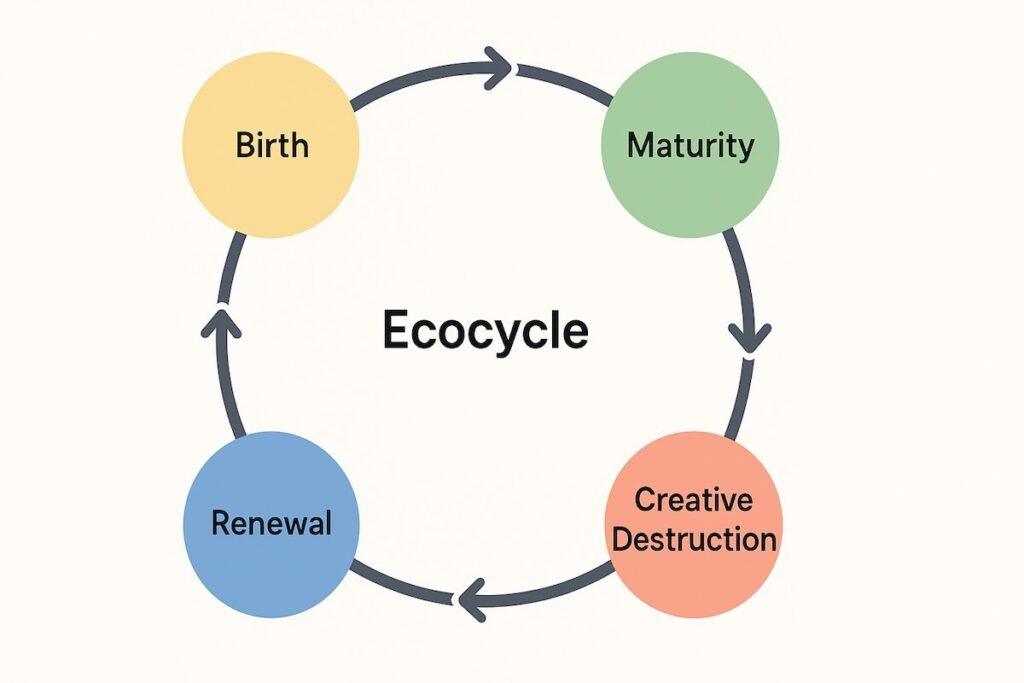
The ecocycle is not a simple step-by-step process. It’s a continuous loop with feedback between each stage. Each part—Birth, Maturity, Creative Destruction, and Renewal—is not just a phase but a way of thinking.
For example:
Growth needs bold investment.
Maturity requires careful management.
Destruction calls for courage to let go of what’s outdated.
Renewal encourages new ideas and experiments.
This model works because it’s easy to see and understand. Teams can use sticky notes, online canvases, or the Liberating Structures app to map out projects. This makes complex problems clear and manageable.
The Four Stages of the Ecocycle Mental Model
1. Birth/Growth Phase
In this phase, new ideas, projects, or initiatives emerge and begin to develop. Resources are invested to nurture growth, and there’s typically high energy and enthusiasm. In organizations, this represents new products, services, or strategies being developed. The leadership stance here is entrepreneurial, focused on exploration and possibility.
2. Maturity/Conservation Phase
As initiatives mature, they become more efficient and productive. Systems in this phase are optimized, stable, and generate maximum value. However, they also become more rigid and potentially resistant to change. The leadership stance shifts to managerial, focusing on efficiency and optimization of existing processes.
3. Creative Destruction Phase
Eventually, all systems reach a point where they must be partially or completely dismantled to make way for renewal. This phase involves letting go of outdated practices, products, or beliefs that no longer serve their purpose. The leadership stance here is that of a heretic, willing to challenge the status quo and release what’s no longer working.
4. Renewal Phase
Following destruction comes renewal, where space is created for new growth. This phase is characterized by experimentation, learning, and preparation for the next cycle of growth. The leadership stance is that of a networker, connecting ideas and people to create fertile ground for innovation.
The Traps of the Ecocycle
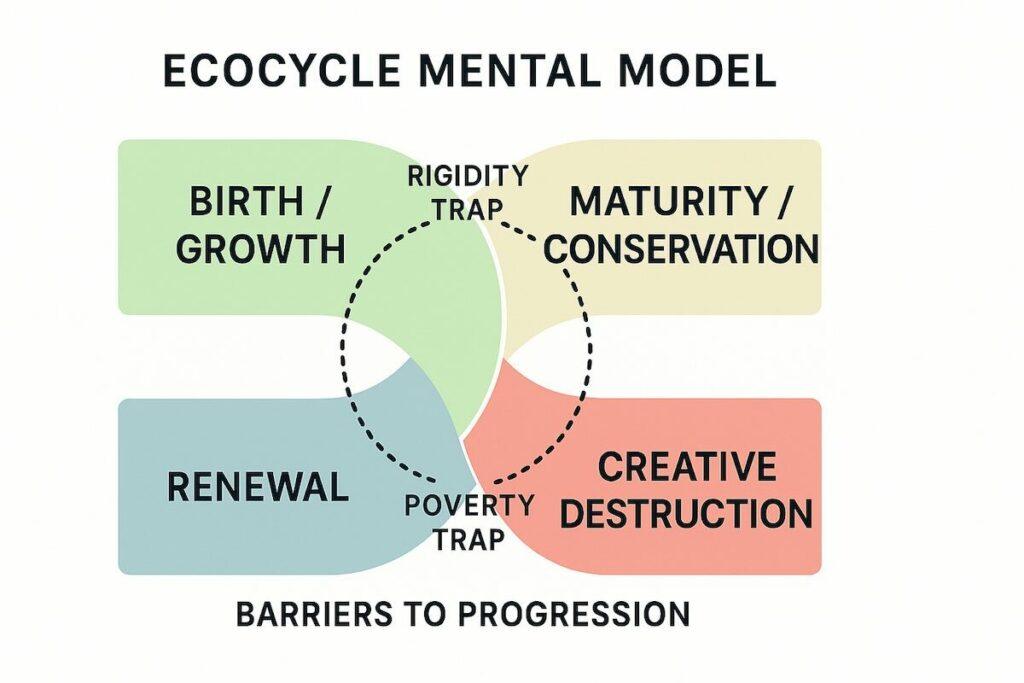
The ecocycle model also identifies two common traps that prevent healthy progression through the cycle, affecting how organizations list activities and manage relationships:
The Rigidity Trap
Organizations or systems can become stuck in the maturity phase, unable to let go of established practices even when they’re no longer effective. This resistance to change leads to stagnation and eventual crisis. Examples include companies like Kodak, which understood digital photography was coming but couldn’t adapt quickly enough to avoid bankruptcy.
The Poverty/Scarcity Trap
This trap occurs when promising initiatives in the birth or renewal phases don’t receive enough resources to develop fully. Ideas remain perpetually underdeveloped, never reaching their potential. This is common in organizations that spread resources too thinly across too many projects.
Practical Applications of the Ecocycle Mental Model
The ecocycle framework offers valuable insights across multiple domains. Here are some practical ways to apply this mental model:
Business Innovation
Organizations can use the ecocycle to analyze their product portfolios, identifying which offerings are in growth, which are mature and generating value, and which should be phased out. This prevents the common mistake of holding onto declining products too long while starving promising innovations of resources.
Team Development
Scrum teams and project groups can apply ecocycle planning to evaluate their practices, meetings, and relationships. This helps identify which activities add value, which have become rigid routines, and what new approaches should be explored to improve team performance.
Personal Development
Individuals can map their skills, habits, relationships, and projects on the ecocycle to gain clarity about what to nurture, what to maintain, and what to let go of. This creates space for personal growth and prevents burnout from holding onto too many commitments.
The Sweet Zone of Sustainability
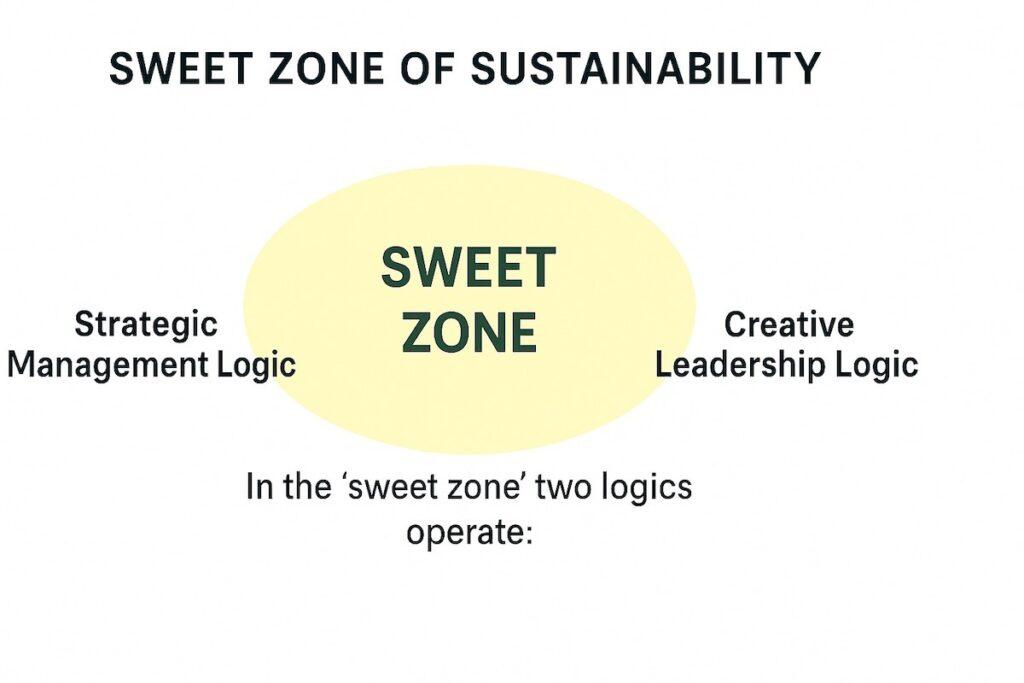
David Hurst, who adapted the ecocycle for organizational contexts, identifies a “sweet zone” between the two traps where sustainable performance occurs.
In this zone, two logics operate: activities relationships and consensus among team members help organizations move forward effectively, ensuring a balanced portfolio of activities that drive both purpose and efficiency.
Strategic Management Logic
This is the logic of large systems, concerned with finding and implementing effective means to given ends. It allows growing organizations to be rationalized and handle scale efficiently.
Creative Leadership Logic
This is the eco-logic of people, concerned with finding desirable ends – purpose and meaning – for the organization and its people. It’s synonymous with contextual intelligence and practical wisdom.
When leaders can balance these two logics in an effective dialogue between ends and means, organizations can “dwell” in the sweet zone for extended periods, maintaining adaptability while delivering consistent value.
The Sweet Zone: Balancing Strategic Management and Creative Leadership
Case Study: Applying the Ecocycle Mental Model
Technology Company Transformation Through Ecocycle Planning
Consider a mid-sized technology company that had been successful with its flagship software product for over a decade. As market conditions changed and new competitors emerged, the company found itself struggling to maintain growth. Using the ecocycle mental model, the leadership team conducted a comprehensive analysis:
Identifying the Rigidity Trap
The team discovered that 70% of their development resources were dedicated to maintaining and incrementally improving their legacy product, which was showing declining revenue. The organizational structure and processes had been optimized for this product, creating resistance to change. By mapping these activities in the maturity/rigidity trap area, they gained clarity about what needed to be released.
Addressing the Poverty Trap
Several promising new product ideas had emerged over the years but remained underdeveloped due to resource constraints. By identifying these initiatives in the poverty trap, the team could make deliberate decisions about which ones to invest in and which to abandon completely.
Creative Destruction Actions
The company made the difficult decision to sunset certain features of their legacy product, reassign team members, and simplify their offering. This freed up resources and created space for innovation. They also restructured their development process, moving from a rigid waterfall approach to a more adaptive agile methodology.
Renewal and Growth Outcomes
With newly available resources, the company invested in two promising initiatives: a cloud-based version of their core product and a complementary service offering. Within 18 months, these new offerings accounted for 40% of revenue, and the company returned to growth. By continuing to use ecocycle planning quarterly, they maintained a healthier balance across their product portfolio.
Using the Ecocycle Mental Model in Strategic Planning
Strategic planning often uses tools like SWOT or OKRs. These tools don’t capture the real behavior of systems. The ecocycle offers a flexible way to see both opportunity and waste.
For example:
In product development, the model helps identify features to retire and areas ready for investment.
In talent management, it highlights employees who are ripe for growth vs. those stuck in outdated roles.
In budgeting, it reveals which areas are overfunded without return and which innovative projects are starved for resources.
Teams that revisit their ecocycle map quarterly report greater alignment, agility, and ROI. It becomes a visual operating system for continuous renewal.
Actionable Tips for Applying the Ecocycle Framework
Ready to put the ecocycle mental model into practice? Here are concrete steps to apply this framework in your context, leveraging liberating structures to identify opportunities at various levels and track your progress:
1. Map Your Current State
- List all activities, projects, products, or relationships in your domain
- Place each item in the appropriate phase of the ecocycle
- Identify clusters and patterns – where is most of your energy going?
- Look for items stuck in the rigidity or poverty traps
2. Create Action Plans
- For items in the rigidity trap: Develop specific plans to phase out, simplify, or transform
- For items in the poverty trap: Decide which to resource properly and which to abandon
- For items in growth: Identify what support they need to flourish
- For items in maturity: Determine how to maintain value while preventing rigidity
3. Implement and Review
- Schedule regular ecocycle planning sessions (quarterly works well)
- Track movement of items through the cycle
- Celebrate successful transitions and creative destruction
- Adjust resource allocation based on evolving patterns
Facilitation Tips for Group Ecocycle Planning
The Ecocycle makes it possible to sift, prioritize, and plan actions with everyone involved in the activities at the same time, as opposed to the conventional way of doing it behind closed doors with a small group of people.
- Start with individual reflection before moving to pairs and then groups
- Use sticky notes to make placement visible and movable
- Include diverse perspectives – those inside and outside the system
- Focus first on items with clear consensus about their placement
- Create specific first action steps for items in both traps
- Discuss items where there’s disagreement about placement
- Document the process and revisit regularly to track movement
Embracing the Cycle of Adaptation and Renewal

The ecocycle mental model offers a powerful lens for understanding the natural progression of complex systems. By recognizing that all systems move through phases of birth, growth, maturity, creative destruction, and renewal, we can work with these natural cycles rather than against them.
The most resilient organizations, teams, and individuals are those who can navigate all phases of the ecocycle effectively – nurturing new growth, optimizing mature systems, courageously releasing what no longer serves, and creating space for renewal.
By avoiding both the rigidity and poverty traps, they maintain adaptability in changing environments.
As you apply the ecocycle framework to your own context, remember that it’s a tool for anticipation rather than prediction. It helps you identify patterns and make conscious choices about where to invest your energy and resources.
The goal isn’t to avoid creative destruction but to embrace it as a necessary part of ongoing renewal and adaptation.
Conclusion
The ecocycle mental model changes how we see complexity. It views it as natural, necessary steps. Instead of sticking to old ways or jumping into new ones too fast, it helps us balance exploration with efficiency.
This model is great for anyone leading a startup, running a nonprofit, or working on personal growth. It teaches adaptive leadership. It shows us that renewal comes through release. And that lasting strength comes from going through growth, maturity, destruction, and rebirth over and over again.
Apply this model for more than just understanding. Use it for strategic action, to plan and make smart changes. The ecocycle is not just a tool—it’s a way of thinking.
Deepen Your Understanding
Explore David Hurst’s comprehensive analysis of the ecocycle mental model and its applications in complex systems.
